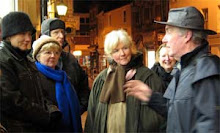Not exactly the South West I grant you, but during a recent visit to Wimbourne in Dorset, I couldn't resist taking a detour on the way home and stopping off at the 12th century Norman church near Brockington, said to be one of Dorset's most haunted.
The church; now a ruin, stands at the centre of a Neolithic henge which dates from around 2500BC. It's but a small part of a complex of barrows and earthworks known as the 'Knowlton Rings' which comprise of the North Circle, South Circle, Church Circle and the Old Saxon Graveyard; the latter all but disappeared; a consequence of agriculture. To the east of the Church Circle lies the Great Barrow; the largest round barrow in Dorset, just one of 35 barrows that make up the Knowlton Rings.
Two standing stones were unearthed by dowsers in 2000, one of which bore several concentric circles, reminiscent of Neolithic art. The standing stones (it is thought there were several at one time) were either toppled and buried or broken up and used for building material during the transition from paganism to Christianity. It was not uncommon to see such destruction of pagan sites by Christians who viewed this gentle Earth religion as ungodly. One only has to look at the destruction at Avebury to get an idea of the devastation. It is likely therefore that Knowlton Church may well have been constructed, in part at least, from these stones, possibly a statement that Christianity had triumphed over paganism.
Knowton Church is all that remains of a once thriving community that fell victim to plague in the 14th century. As a consequence, the village fell into ruin, only the church survived. It continued to draw a small congregation until around 1650 when services ceased. In the 18th century, a brief period of restoration followed. A new roof was erected, which collapsed shortly after its completion. This spelt the end for Knowlton church.
The church is probably best remembered for its peel of three bells. When it closed; one bell went to Sturminster Marshall, one to Shapwick and one, the most famous of all, remained in the tower.
There are several versions of what happened to this particular bell. Some say the devil stole it and discarded it in the River Stour, whilst others claim thieves from Sturminster Newton wanted the bell for their own church so hatched a cunning plan to steal it.
In the dead of night they took the bell from the tower and concealed it on a cart pulled by two horses. As they made their way back to Sturminster Newton a local farmer spotted them and raised the alarm. A 'posse' of local men were mustered and arrived back at the scene but the thieves were long gone. The men sort advice from a local witch (as you do when you're bell's been knicked) who promptly cast a spell which stopped the horses dead in their tracks. No amount of encouragement by the thieves would entice the horses to cross the bridge at White Mill. Fearing the animals had been bewitched, the thieves decided to roll the bell across the bridge by hand. Half way across they lost their footing and the bell fell into the Stour. They tried in vain to retrieve the bell but gave up for fear of being caught.
The witch told the men where the bell could be found. Come daybreak they made their way to the bridge with horses. Ropes were attached to the bell in an effort to pull it from the depths but these snapped time after time. Eventually the men gave up and the left the bell where it is said it still remains to this day. When the village floods, which it does from time to time, some say you can hear the bell eerily tolling as it rocks beneath the raging waters.
There are many ghosts said to haunt the Church. A shadowy, caped figure has been seen walking the henge, sometimes accompanied by a giant hound. A figure has been spotted in the tower. There are numerous accounts of a woman kneeling before the ruin; possibly that of a nun.
It's a mysterious, enchanting place, where one can easily see why it has gained a reputation for being haunted. Just beyond the henge, in a little glade stands an ancient tree, on its branches hang countless eulogies; sorrowful reminders of those no longer with us. Taking a moment to read just a few, some clearly written by children; one can't help but be moved.







No comments:
Post a Comment